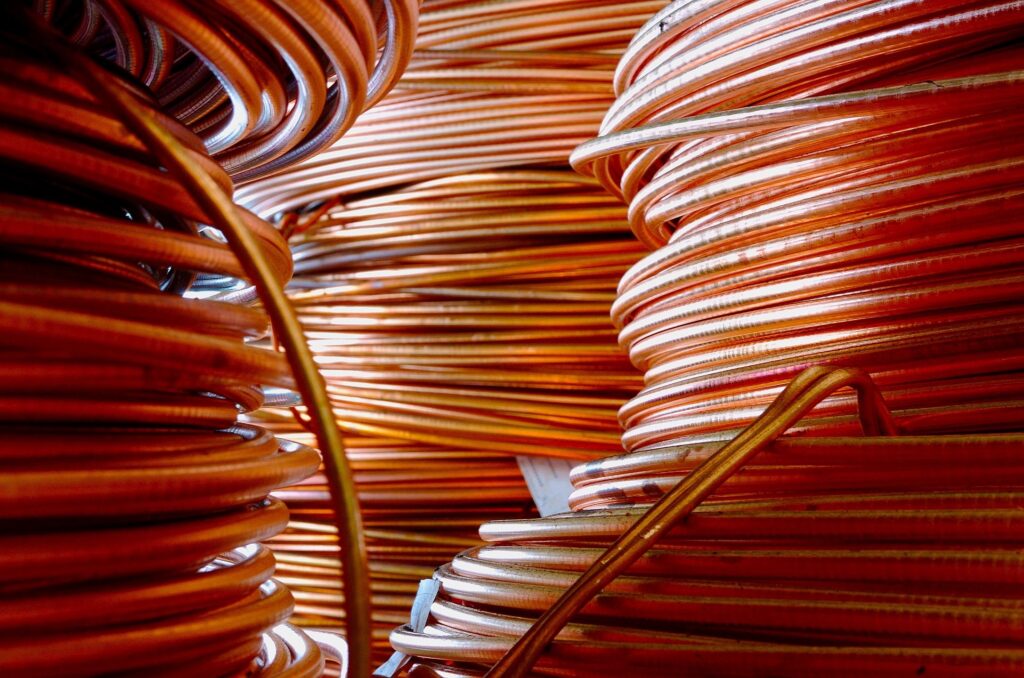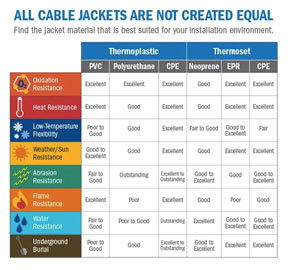In every issue of Wiring Harness News, Anixter will bring you informative articles about wire and cable technology.
Cable Jacket Types 101
Almost every cable has a jacket and for good reason: jackets help mechanically protect the insulation and conductor core of the cable. Without a jacket, cables are susceptible to abrasion, heat damage and oxidation damage, as well as weather-related damage. But not every jacket is created equal; it is imperative that each cable have the correct jacket type for each application in order for the cable to operate properly.
This Wire Wisdom will explore some of the different cable jacket types and provide an overview on the jackets’ mechanical and chemical properties.
What Is a Cable Jacket?
A jacket is the outermost layer of a cable. Its primary function is to protect the insulation and conductor core from external physical forces and chemical deterioration. The cable jacket is the first line of mechanical defense for a cable, protecting its inner components. Cable jackets offer mechanical, moisture, flame and chemical protection while also protecting the cable from damage during or after installation. It is important to note that the cable jacket has little to do with the electrical performance of the cable.
Thermoplastic Cable Jackets
Polyvinyl chloride (PVC) jackets, while not exhibiting a wide range of thermal characteristics, do have the ability to resist oils, acids, sunlight, heat, weathering and abrasion. By having such strong physical assets, PVC is an ideal jacket for cables that will be used for direct burial, street lighting and control cable. Since PVC is inherently flame retardant, it is the most common jacketing material for electronic cable.
Polyurethane (PUR) jackets have excellent oxidation, oil and ozone resistance, and when specially formulated, can also have good flame resistance. These types of jackets also have great “memory” properties, which make them ideal for retractile cords.
Chlorinated polyethylene (CPE) is one of the few polymers that is available as both a thermoplastic and a thermoset jacket (thermoset CPE would be a cross-linked version). The thermoplastic CPE jacket has excellent oxidation, heat, oil, weather/sun and flame resistance. Although the thermoset version has better high-temperature properties, the thermoplastic version contains other excellent properties.
Thermoset Cable Jackets
Neoprene is a synthetic rubber that allows for a resilient jacket. By not embrittling at cold temperatures, resisting permanent deformation under heat, and resisting aging due to oxidation and sunlight, neoprene jackets are suitable for cables in rugged environments, such as mine trailing cables and dredge cables.
Ethylene propylene rubber (EPR), another form of synthetic rubber, is a type of jacket that is a modified form of the EPR insulating compound. EPR jackets have excellent heat, abrasion and oxidation resistance and can also withstand cold temperatures down to -60°C. With fairly good high-temperature characteristics overall, when formulated correctly, EPR can be rather flame retardant as well.
Thermoset CPE (cross-linked) has excellent physical properties that make it suitable for many cable jacket applications. This polymer is resistant to ozone and ultraviolet degradation, and if properly compounded, can also withstand prolonged immersion in water. With strong resistance to most acids, bases and solvents, thermoset CPE jackets are well-suited for chemical plant use.
Properties of Cable Jackets
As stated earlier, jackets provide mechanical protection to the insulation and conductor core. In order to provide the best possible protection for the cable, a jacket can be modified by the addition of fillers, plasticizers, activators and inhibitors to enhance a particular physical characteristic. Some of those physical characteristics are as follows:
- Toughness, tear and abrasion resistance
- Flexibility during cable installation, at low temperatures
- Stability over a range of temperatures
- Resistance to heat aging
- Resistance to cable deformation
- Flame resistance
- Oil resistance
- Low moisture absorption
- Resistance to abnormal concentrations of chemicals
- Weather and ultraviolet resistance
For help choosing the best cable jacket for your application, visit anixter.com/contact to get in touch with an expert.































































